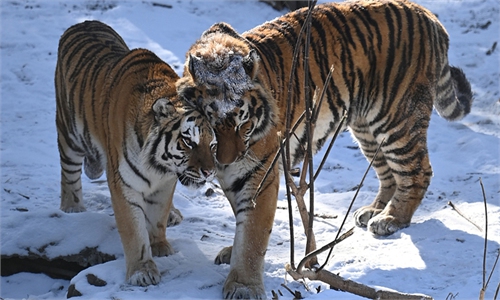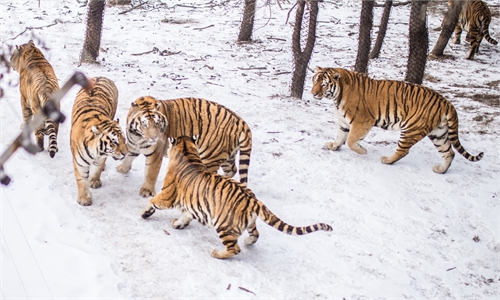IN-DEPTH / IN-DEPTH
Big cats well protected in Northeast China thanks to national park, advanced technology
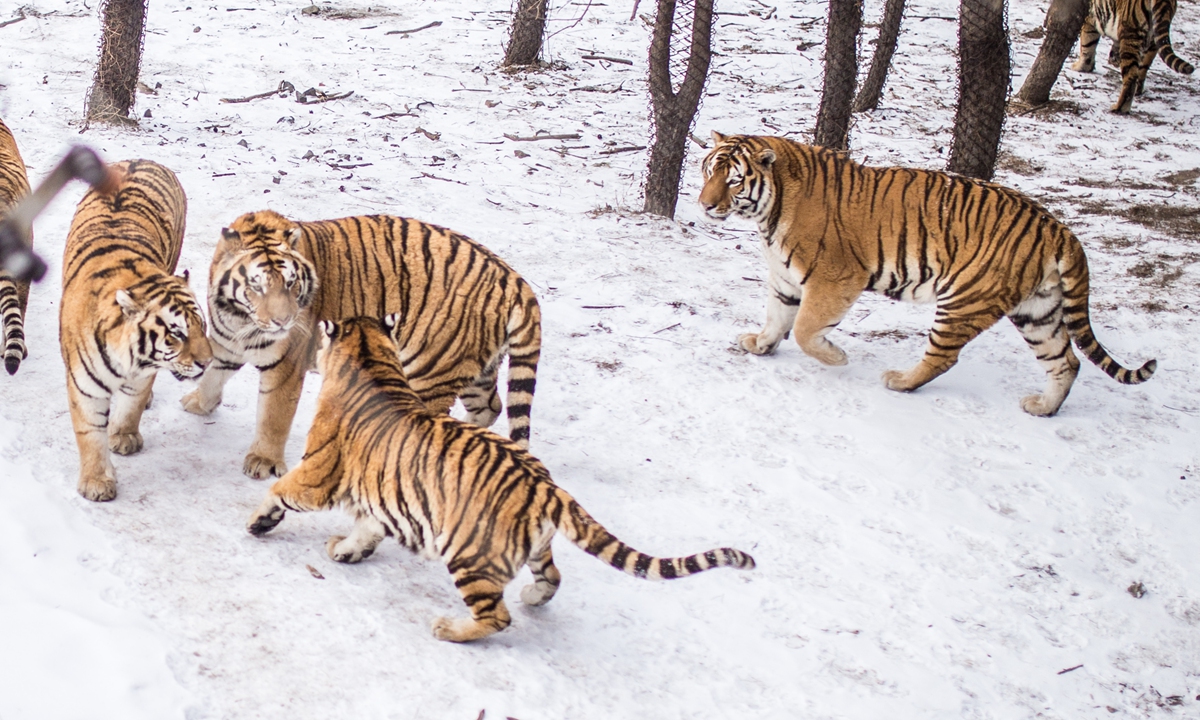
Siberian tigers play in the Jilin Northeast Tiger Park in Changchun, Northeast China's Jilin Province on February 12, 2023. Photos: Shan Jie/GT
Li Wanlu clicks on the latest video clip she received, and can't help but grin.
On the screen are two Siberian tiger cubs play-fighting in the snow.
The tigers live in uninhabited woods hundreds of miles from where Li is sitting - right on the top floor of the headquarter of Hunchun Forestry Bureau in Northeast China's Jilin Province.
The animals' actions were captured on one of the real-time transmission cameras installed in the forests. Every day, Li, a technician at the bureau, receives video clips freshly captured by the cameras. Li's team has six members, who are divided into three shifts conducting 24/7 monitoring.
Not only are there Siberian tigers at the park, but Amur leopards, sika deer, and other precious and protected wildlife species are also recorded by the system.
Over the last few years, China's national park system has been successful in safeguarding wildlife species in their natural habitats, and advanced technologies have been innovated through the process.
In October 2021, during the 15th Conference of the Parties (COP15) of the Convention on Biological Diversity (CBD) held in Kunming, Yunnan Province, China officially designated an area for the Northeast China Tiger and Leopard National Park, which spans an area of over 1.4 million hectares in the northeastern provinces of Jilin and Heilongjiang, the culmination of efforts which started in 2016.
Siberian tigers, also known as Amur or Manchurian tigers, mainly live in eastern Russia, Northeast China, and the northern part of the Korean Peninsula. Amur leopards, also known as the Far Eastern leopard, are one of the most endangered felines in the world and have been listed as critically endangered by the International Union for Conservation of Nature.
The Government Work Report Chinese Premier Li Keqiang delivered to the first session of the 14th National People's Congress, which opened on Sunday, noted that China's ecological environment has improved markedly over the last five years. The first batch of national parks has been established, and more than 9,000 nature reserves of various levels and types have been established. A major step has been taken in the creation of a beautiful China.
Recently, the Global Times reporters visited the park, talked with wildlife experts, and strolled in the snow with the woods patrol team, taking a closer look at how China has made efforts to protect wildlife and maintain ecological balance, as well as how advanced technologies and international cooperation have facilitated the protection.

Li Wanlu (right) and her colleague monitor wildlife at the Hunchun Forestry Bureau in Northeast China's Jilin Province on February 14, 2023 Photo: Shan Jie/GT
Snapping big cats
Meng Xin, Li's colleague, navigates through the knee-deep snow in forests and performs maintenance work on the cameras attached to the bases of various trees.
"Compared with previous years, the monitoring of tigers and leopards this year has shown an increase in frequency, including an increase in the number of newborn cubs and an improvement in their survival rate," Meng said.
"Monitoring also shows improvement in the big cats' habitats, surrounding vegetation, and food chains respectively," he said. "In addition to tigers and leopards, the number of endangered species such as sika deer, bears, and others is also increasing."
There are 5,746 such real-time transmission cameras scattered across the park's jurisdiction, which capture real-time images triggered by animal infrared sensing cameras. The platform utilizes 700 Mbps real-time transmission, and within a few minutes, monitors such as Li can see the live footage from the wilderness.
This system plays a significant role in protecting tigers and leopards, in forest fire prevention, and in forest resource management, Meng told the Global Times.
The total area under the jurisdiction of the Hunchun Forestry Bureau is 348,000 hectares, including a 276,000-hectare area which is in the national park.
In the region, these primeval forests are covered by birch trees and various plants and are home to many wild animals. Located on the border neighboring both North Korea and Russia, visitors must also pass through the border defense checkpoints.
Along with the launch of the pilot project of the Northeast China Tiger and Leopard National Park in 2016, a space-air-ground integrated network system was also built.
When the system was put into use in 2018, a total of 9,798 videos of Siberian tigers, 15,356 videos of Northeast leopards, 455,402 videos of sika deer, 108,932 videos of wild boars, and 313,683 videos of roe deer have been captured in the jurisdiction of the Hunchun bureau.
From November 2021 to the present, thanks to the system, a total of 4,533 alerts, warnings of large predators such as tigers, leopards, and bears approaching, have been sent to the local forestry bureau, border defense forces, townships and villages' officials, which serves to protect both the animals and humans.
In addition, a series of measures have also been put in place. For example, warning facilities have been set up in the key areas where tigers and leopards breed. Ecological restoration is continuously promoted, and the migration corridors of Siberian tigers and leopards are kept open to enhance habitat connectivity. Efforts have also been made to reduce human activities that destroy the stable habitats of wild tigers and leopards.
With habitat improvement, the number of Siberian tigers and Amur leopards in the Hunchun bureau has increased from the initial 27 tigers and 33 leopards from the two pilot projects in 2016 to over 40 tigers and over 50 leopards so far, the Global Times learned from the bureau.
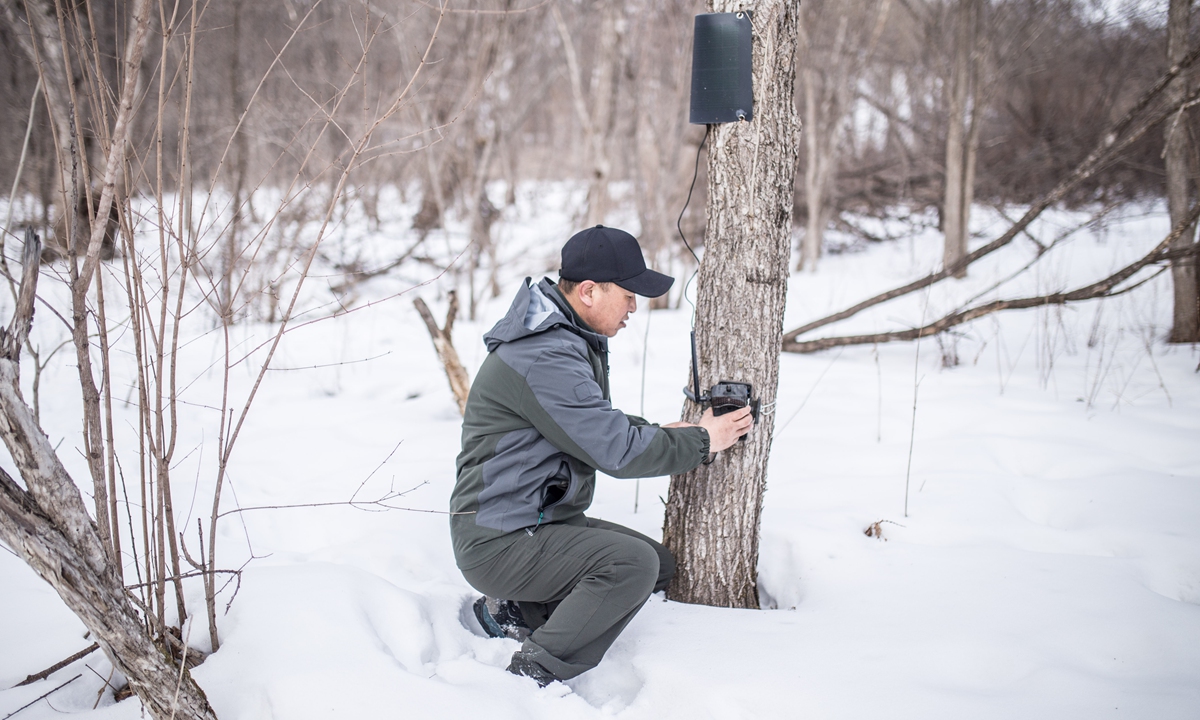
Meng Xin checks a camera in the forest of Hunchun Forestry Bureau in Northeast China's Jilin Province on February 14, 2023 Photo: Shan Jie/GT
Forest guardians
The Hunchun bureau, which is administrated by the Changbai Mountain Forestry Group, was once prosperous because of logging and selling timber. In the year of 2000, China launched the Natural Forest Protection Project, and logging was completely halted in Hunchun since 2016.
The older generation of workers was once comprised of loggers, but now the staff here has signed up to be guardians of the forest.
Meng Chuan, the vice director of the Sandaogou protection station of the Hunchun bureau, was leading his squad on a patrol when the Global Times reporters met him deep in the woods. The team members slid from a hill covered in heavy snow adroitly.
Meng has been working in the forestry system for more than 20 years. He became a patroller a year ago after serving in the fire prevention department.
"We protect every link in the tiger's food chain, including deer and roe deer. We record their activities and excrement to understand the distribution and health of the wildlife in the area," he said.
"We also tell local villagers in the jurisdiction about the importance of wildlife protection and to take the responsibility of forest fire prevention," Meng said. "Although the work is tough, we are happy to be wildlife conservationists because we have observed the gradual growth of wildlife through our efforts."
According to Meng, the patrol teams here have not really encountered tigers in the last few years. However, visitors to Changchun, the capital of Jilin Province 500 kilometers away, can get a close-up view of the Siberian tigers.
The Jilin Northeast Tiger Park was established for the timely rescue of injured and sick wildlife, as well as the conservation of endangered species. It is also a large park that integrates the rescue, breeding, wildness, and viewing of precious and endangered wild animals such as Siberian tigers.
"At present, we have more than 50 Siberian tigers and have established a pedigree of Siberian tigers," Wang Haijun, director of the animal management department of the park, told the Global Times. "The captive breeding of Siberian tigers is a supplement to wild Siberian tigers and has the function of popularizing science and education."
"We hope that the general public, especially children, will recognize and understand wild animals such as tigers and leopards, and enhance their awareness of wildlife protection," Wang said.
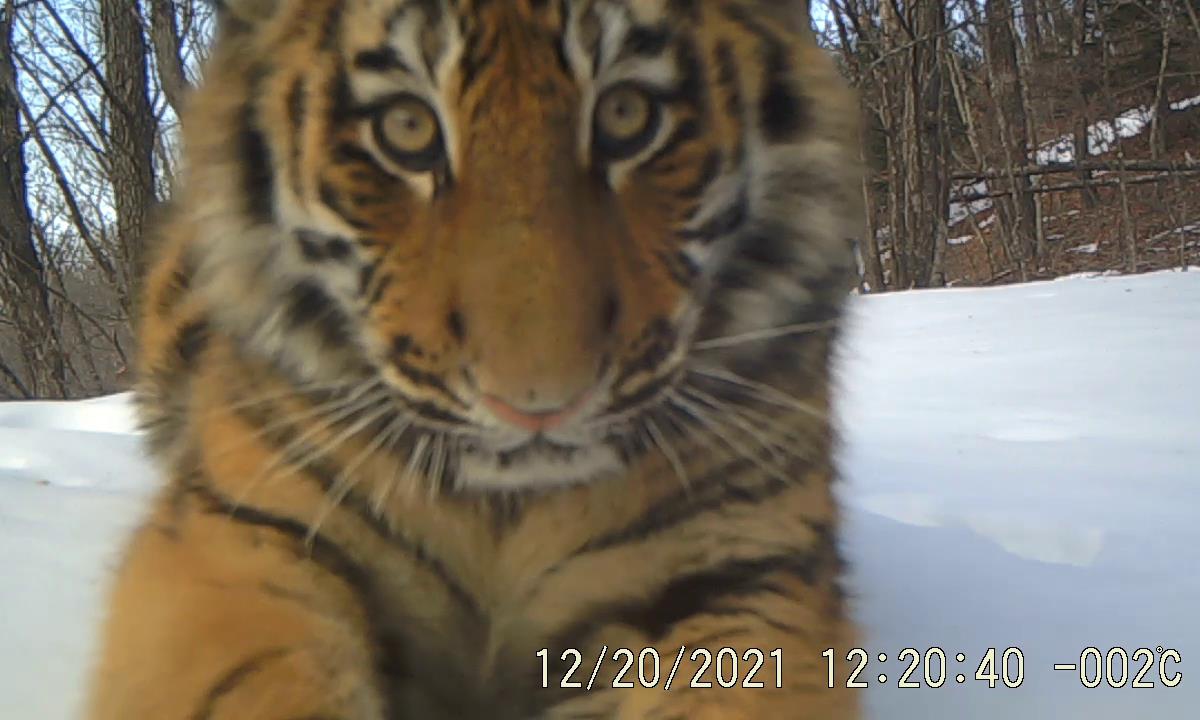
A wild Siberian tiger cub captured by camera Photo: Courtesy of the Hunchun Forestry Bureau
International cooperation
According to the statistics from the WWF, after years of conservation efforts, the survival of wild tigers in China has gradually improved, and conservation work has achieved encouraging results. The number of wild Siberian tigers in China has been on the rise, with multiple wild tiger breeding families and an annual growth rate of about 1.04 percent.
In November 2019, the Northeast China Tiger and Leopard National Park and Russia's Land of the Leopard national park signed a cooperative action plan to beef up cooperation in the protection of Siberian tigers and Amur leopards.
It includes 14 action plans and nine long-term activities, containing special research on the cross-border activities of tigers and leopards, data sharing, and nature reserves ecological protection experience exchanges.
For frontline conservationists, one of the most direct manifestations is the increasingly frequent appearance of tigers as captured by the cameras.
"My happiest moment is seeing tiger cubs curiously facing the camera," Li said. "The activities of the Siberian tigers are increasing, and the number of cubs is also increasing. I hope that under our strong protection, they will live better and can migrate, breed, and produce more cubs within China."
Li and his colleagues also select videos of wild tigers, leopards, and other animals to post online to raise awareness of wildlife conservation.
"Others may say they are indulging in cyber cat petting, but I pet tigers via our network," Li said.


